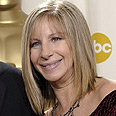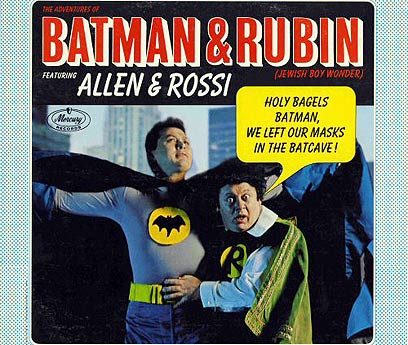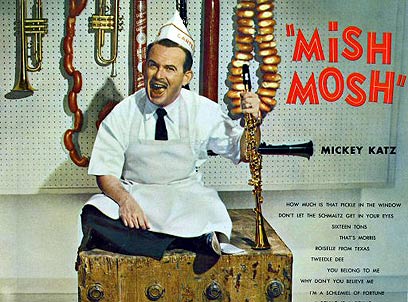
America's Jews through vinyl
New compilation of old Jewish record albums is a touching, fascinating and at times hilarious account of US Jews' cultural history
Like many children of any faith Roger Bennett and Josh Kun found the religious instruction of their youth boring and irrelevant.
But something must have seeped in because decades later while collecting kitschy Jewish album covers they uncovered musical and cultural gems that could have redeemed Hebrew School.
Their discoveries are recorded in a new book "And You Shall Know Us By the Trail of Our Vinyl," - a compilation of Jewish record albums from the 1940s through the 1970s.

Cover of record album 'Batman & Rubin' by artists Marty Allen and Steve Rossi for the Mercury label released in 1967 (Photo: Reuters)
"My frustration with Hebrew School was that it didn't speak to who I was or who I wanted to be. It didn't engage with life outside of Hebrew School," said Kun.
One of their finds, a mambo-style 1959 album called "Bagels and Bongos", might have spiced things up in synagogue, while "Corned-Beef Confucius," by Max Asnas from the 1950s, could have provided some laughs.
But Bennett and Kun insist the book is more than a nostalgic look at Jewish popular culture. It is a point of departure into a future that will be enriched by an infusion of the past.
Q: Why a book all about records?
Bennett: "Everyday objects tell stories that are more powerful than people think at first glance. We can use objects to frame questions to make people think about who they are, what they're inheriting and what it means to them."
Kun: "People look at this and say, 'Why does this matter?' Our work has been to tell people why. One of the most fun things about this project has been translating this love into terms people can understand."

Cover of record album 'Mish-Mosh' by artist Mickey Katz for the Capitol label released in 1957 (Photo: Reuters)
Q: How did you go about collecting all of these records?
Kun: "The work we've done with this music up to this point has been done as a small nonprofit, a labor of love. We devoted as much time as we could, taking weekends, stopping by garage sales and meeting with musicians."
Bennett: "We do feel a sense of urgency because these people are passing away."
Q: Who was an exceptionally surprising and satisfying find?
Bennett: "Jon Yune. Only in America could a Korean immigrant do a record of Hebrew and Yiddish songs. He still closes every one of his Vegas shows with "Exodus" because it not only reminds him of his relationship to Jewish music. He sees in Jewish history a parallel to the suffering of his own people."

Cover of record album "The Battle for Jerusalem! The Six Day War" by artist Alfred Eris and Russ Hall for Audio Rarities label released in 1967 (Photo: Reuters)
Q: What did this book teach you about post-war Jewish popular culture?
Bennett: "When we thought of Jewish music we thought of the holy trinity of Barry (Manilow), Barbra (Streisand) and Neil (Diamond). But we discovered a whole world. That framed one giant question, which was why had we never heard of any of this stuff? What's left out is so compelling. Ultimately this is not a book about music. It's about how four generations lived in America and using the albums to tell history."
Q: So putting this book together put your own Jewish identity in a different light?
Bennett: "This book began by us just collecting orphaned vinyl and then trying to track down as many of the performers as we can find. We have found role models in talking to them. I felt like neither of us had a friend under 80! I've found Jewish role models that are fascinating, extremely compelling, articulate -- that I wish I'd had at Hebrew School."










